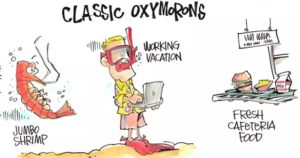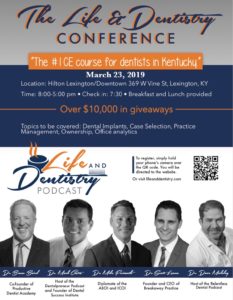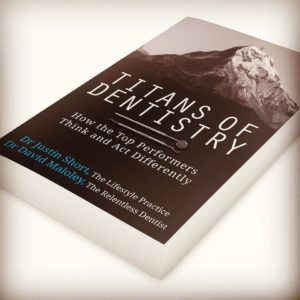by [email protected] | Apr 17, 2019 | Maverick Mind Shifts
Podcast: Play in new window | Download
 Being on the road a lot, I get the chance to hear a lot of stories and gain a ton of great insight from fellow dentists and practice owners. Today, I’ll be catching up the last few months and sharing what I’ve learned and some important conversations I’ve been having.
Being on the road a lot, I get the chance to hear a lot of stories and gain a ton of great insight from fellow dentists and practice owners. Today, I’ll be catching up the last few months and sharing what I’ve learned and some important conversations I’ve been having.
Listen in to hear how the title of the podcast is an intentional oxymoron as I reflect on why that name was chosen and how it still rings true. I will also discuss the importance of sharing our challenges in order to help ourselves and others, as well as my own struggles I’ve faced. You’ll get the full story of where I broke, the challenges I dealt with as it all became too much, and how I pulled through in the end.
Tune in to more Maverick Mind Shifts Podcast Episodes
Key Quotes:
- “It all got to the point where I could barely get out of bed in the morning – this is when you really need to connect to a why.”
- “I thought dentists lacked courage, they lacked tenacity and grit. And I knew if we could just establish more commitment, more clarity, more courage, dentists could start connecting their head to their heart again.”
- “I didn’t label myself the relentless dentist. It was the name of my podcast because I wanted to instill more courage.”
- “I would make promises to Bennet that I didn’t know how I would get through this, but I would find a way.”
- “The recipe between who you are now and who you want to be is always courage.”
- “If you’re not exhibiting courage, you’ll start to become a slave to your practice.”
Featured on the Show:


by [email protected] | Mar 13, 2019 | Wealth Wisdom
Podcast: Play in new window | Download
 Today I’ve got four friends on the line to talk about life, dentistry and the Life and Dentistry Conference coming up on March 23rd. Lewis, Scotty, Cole and John are all part of the Life and Dentistry team, and they’re here to share their vision and passion for bringing great dental minds together in a fun and inspiring way.
Today I’ve got four friends on the line to talk about life, dentistry and the Life and Dentistry Conference coming up on March 23rd. Lewis, Scotty, Cole and John are all part of the Life and Dentistry team, and they’re here to share their vision and passion for bringing great dental minds together in a fun and inspiring way.
In this episode, you’ll get a taste of what to expect from the Life and Dentistry Conference, as well as our thoughts on how the last few years have made an impact and helped us grow. It’s important to nurture yourself and keep growing on a personal level as you grow your dental practice, and that’s what this conference is all about. You’ll get inspiration from real people who have gone through real struggles and gain insight to help you in your life and career.
Tune in to more Wealth Wisdom Podcast Episodes
Key Quotes:
- “We just want to add value to others. We just want other people to grow in a lot of aspects of life. That’s why we call ourselves Life and Dentistry.”
- “It’s the lack of connection that kept me under for so long.”
- “Every person’s path should be unique, but you can borrow ideas, steal clues, get leveled up by tapping the minds of people who’ve been through it.”
- “It’s important to show some drive and stick to it.”
- “The one danger zone I see dentists fall in is comfort.”
- “They have the capability, but they don’t have the courage, and so that can be a really strong boundary that keeps people stuck for decades.”
- “The most successful people in dentistry and life fail a lot.”
- “If you don’t have something to work towards, if you’re not striving to get bigger and better, you’re getting worse.”
- “Success definitely leaves clues, but true success is a byproduct of alignment.”
- “You gotta step out of your comfort zone and you gotta know where you want to be, even if it means sacrificing being comfortable right now.”
Featured on the Show:


by [email protected] | Feb 27, 2019 | Wealth Wisdom
Podcast: Play in new window | Download
 In this episode, I’ll be sharing a presentation I delivered at the Voices of Dentistry event last month. A lot of energy went into this presentation, and if you’re interested in hearing about some of the biggest lessons to be learned from the top titans in dentistry, this is for you. You’ll get some incredible tactical insights about what separates the top dentists from the bottom dentists, how to define success, and much more.
In this episode, I’ll be sharing a presentation I delivered at the Voices of Dentistry event last month. A lot of energy went into this presentation, and if you’re interested in hearing about some of the biggest lessons to be learned from the top titans in dentistry, this is for you. You’ll get some incredible tactical insights about what separates the top dentists from the bottom dentists, how to define success, and much more.
Listen in to learn what practice growth really means and the best way to focus on growing personally and professionally. The importance of building a team and supporting your organization through exceptional leadership is definitely a key component here, as well as accountability, overcoming difficulty, balance, and clarity.
Tune in and get more Wealth Wisdom
Key Quotes:
- “I love my life now. I’m so thankful, I’m so grateful—and I’m hungry as hell for more.”
- “What we found out is that success is to be defined on your own terms.”
- “Mine this book, mine this presentation for gems you can apply to your own life.”
- “I was telling people to live their epic life, but I wasn’t.”
- “I knew that if I could climb out of that pit, I would never stop climbing.”
- “Where are you right now? And where do you want to be?”
- “Titans have a growth mindset.”
- “I believe that the values and the mission of the organization support the team.”
- “Titans are accountable. What is the opposite of accountability? Blame.”
- “Clarity is certainly knowing what you want, and you want what you want. It shouldn’t be associated with a lot of guilt, and it shouldn’t be you chasing others’ visions and versions of success.”
- “Forget the how. Know what you want, why you want it, and who you have to become to get it.”
- “Sometimes courage is just listening to your team.”
- “Every one of those decisions can be a step forward into fear or a step backward into comfort.”
- “Dentists are purposeful.”
- “The thing we know for sure is that most of our decisions, most of our activity, is driven by our subconscious mind. We think we’re in control, but we’re mostly in autopilot.”
- “I changed my story, and my results changed.”
Featured on the Show:


by [email protected] | Feb 20, 2019 | Maverick Mind Shifts
Podcast: Play in new window | Download
 This episode is the second of a two-part series featuring my friend Dr. Gina Dorfman, host of the Behind the Smiles podcast and someone who helps people learn to lead and run their practices successfully. In this episode, we continue our conversation with some valuable tips on being an incredible leader and bringing growth and fulfillment to your practice and your team.
This episode is the second of a two-part series featuring my friend Dr. Gina Dorfman, host of the Behind the Smiles podcast and someone who helps people learn to lead and run their practices successfully. In this episode, we continue our conversation with some valuable tips on being an incredible leader and bringing growth and fulfillment to your practice and your team.
We discuss the power of strong leadership and how taking extreme responsibility is actually freeing. You will get a glimpse of how important it is to focus not on external motivations like money, but rather on fulfillment and what makes you excited to come to work. Listen in to learn how assigning more responsibility to your staff and finding people around you with a similar mission will help you create a powerful practice and epic life.
Key Quotes:
- “The fact that you’ve been able to envision this best life ever and then reverse engineer and build it is really incredible.”
- “As much as I tell them what they need, I tell them what they don’t need.”
- “There’s a critical mass that gets hit, and then reputation in a small town takes hold.”
- “To create a sustainable product of my practice, I had to understand the culture at almost a perfected level because I knew a paycheck wasn’t going to be enough to stay competitive in the market.”
- “Stop thinking that leadership is compliance-based; stop thinking that leadership is this hierarchy.”
- “I’m going to stop creating followers. I’m creating that everyone has to be a leader and owner in something.”
- “It’s very love based—they have my back and I have their back.”
- “Every time I’ve cut down days, harvested days out of our practice, production doesn’t go down—it goes up. And so, you can do that when people are performing.”
- “Within our environment, we are in charge. It’s not painful, it’s freedom! Realizing that you’re responsible for everything is truly freedom.”
- “My practice is not limited by its opportunity. It’s limited by its leadership.”
- “The collections and the production seem to just happen as a byproduct of trust and this culture that we built.”
- “In a give-give society there’s no upper limit, but in a give-take society you … reach the bottom really quick.”
Featured on the Show:


by [email protected] | Feb 13, 2019 | Maverick Mind Shifts
Podcast: Play in new window | Download
 This will be the first of a two-part series featuring my friend, Dr. Gina Dorfman, who has just started her own podcast called Behind The Smiles. As someone who helps people learn to lead and run successful practices, Gina has been an incredible part of the dentistry field. In this episode, we discuss common issues dentists face with over-planning and finding their place.
This will be the first of a two-part series featuring my friend, Dr. Gina Dorfman, who has just started her own podcast called Behind The Smiles. As someone who helps people learn to lead and run successful practices, Gina has been an incredible part of the dentistry field. In this episode, we discuss common issues dentists face with over-planning and finding their place.
Dentists tend to get stuck in the how, so Gina and I discuss why it’s important to face fear and take risks in order to get clarity on your next step. We also talk about why courage is so important, what it means to play the long game, and the steps you need to take in order to find fulfillment and success. You can control the legacy and the impact you have by what you’re currently doing, so listen in to get advice on how to make things happen now.
Be inspired! Tune in to more Maverick Mind Shifts Epsodes
Key Quotes:
- “The thing you fear is probably the thing you should be doing.”
- “Play the long game. If you’re a young dentist, you have time on your side.”
- “Sometimes to see the 7th step, you have to be in the 6th step.”
- “My biggest error in my career is that I tried to have more by doing more.”
- “In 2019, safe is pretty risky.”
- “Clarity, whether it’s in leadership or a practice or leading your own life, is a must.”
- “What makes you a really good clinical dentist may make you a terrible business person.”
- “You have to step outside your comfort zone by default to grow.”
- “I was driven by vision, and that’s the thing I got right.”
Featured on the Show:


by Karah Karah | Jan 29, 2019 | Hints for Happiness
Podcast: Play in new window | Download
 Today, I want to share an episode I recorded with Dr. Paul Etchison a while back, which touches on some key things we need to figure out as dentists and practice owners. Paul is the author of Dental Practice Hero, the host of the Dental Practice Heroes podcast, and one of the titans featured in Titans of Dentistry, and he’s someone I really respect because he truly walks the talk. Given his successful career and leadership skills, he’s one of the best people I can think of to have a conversation with about high-performance coaching and being a high-performance individual.
Today, I want to share an episode I recorded with Dr. Paul Etchison a while back, which touches on some key things we need to figure out as dentists and practice owners. Paul is the author of Dental Practice Hero, the host of the Dental Practice Heroes podcast, and one of the titans featured in Titans of Dentistry, and he’s someone I really respect because he truly walks the talk. Given his successful career and leadership skills, he’s one of the best people I can think of to have a conversation with about high-performance coaching and being a high-performance individual.
In this episode, Paul and I dive into the subjects of happiness, fulfillment, and figuring out your purpose. Listen in to hear the major lessons we’ve both learned throughout our careers, what it takes to be a great leader, and why it’s so important for us as dentists to gain clarity on what we really want out of our practices—and out of our lives.
Be inspired! Watch more Hints for Happiness podcast episodes
Key Quotes:
- “The marketplace doesn’t care what degree you have; it matters how much value you’re adding to the system.”
- “We’re all drawn to certain things, and really defining who we are and what we want—getting that crystal clarity—I think is the first step on the escape plan if you feel like you’re on that hamster wheel.”
- “Making sure that you’re progressively trending upward on some kind of key criteria in life is what drives a practice because if you just try and drive a practice with brute force, you’ll get growth, but sustainable growth is questionable because if you’re burnt out, your team isn’t going to show up.”
- “Make sure that you not only know exactly what you want out of your practice and your life, but why you want it, and if you don’t have a compelling why, then it’s time to go back to the drawing board.”
- “When the team shows up, batteries included, and you show up, batteries included, patients feel that goodwill goes up, case acceptance goes up, and it all trickles down to the bottom line.”
- “You can be confident in leadership, but to think that you’ve learned it all and not be engaged in a lifelong journey I think is a dangerous place.”
- “I hope dentists know that if they’re in a tough spot right now, or if they’ve been through a tough spot, or if one’s coming in the future, that’s just part of the game and to anticipate that. To try navigating around that is just wise business, but to think you’ll avoid it completely is a fallacy.”
- “It all comes down to marketing, and once that mind shift happens, life gets a lot easier because you realize that your clinical skills are just one small part of the equation.”
- “You’re your number one asset and your practice is a close second, and sometimes you have to put all the chips in to make sure that you get the results that you need.”
- “If you’re thinking about investing in your team, if you’re thinking about investing in yourself, it’s not hard to get a $1000 idea if you implement it. It’s not hard to get an ROI. It’s making sure you have the intention to actually put your words into actions.”
- “Be crystal clear on what you want, why you want it, and then pursue that dream without guilt or apologies.”
Featured on the Show:


by Karah Karah | Jan 16, 2019 | Hints for Happiness
Podcast: Play in new window | Download
 As we settle into 2019, many of us are thinking about resolutions and what we want to achieve in the new year. But too often, people go about setting goals in the wrong way and end up frustrated and discouraged. So today, I’m going to share an episode I recorded with Joe Blalock and Cole Hackett of the Life and Dentistry podcast that’s all about how to set goals in a way that sets you up for success.
As we settle into 2019, many of us are thinking about resolutions and what we want to achieve in the new year. But too often, people go about setting goals in the wrong way and end up frustrated and discouraged. So today, I’m going to share an episode I recorded with Joe Blalock and Cole Hackett of the Life and Dentistry podcast that’s all about how to set goals in a way that sets you up for success.
Listen in to hear us break down the key ingredients for succeeding when it comes to resolutions, goal setting, and lifestyle design. You’ll learn how to use human nature to ensure your goals work for you and not against you, the common mistakes people make that set them up for failure before they’ve even begun, and what you can do to create habits that will lead you to the life you want.
Be inspired! Watch more Hints for Happiness podcast episodes
Key Quotes:
- “Success is on your own terms, and if you define it, if you’re clear about it, if you don’t let your vision get hijacked, those opportunities are available to each and every one of us at higher and higher levels as our career goes on.”
- “If I do something for ten minutes a day for 365 days, that’s 60 hours of output. There’s not much you can’t become almost a subject matter expert on in 60 hours.”
- “For me, if I set a realistic goal, it’s all in my brain, and I feel like, if I’m going to hit big targets, it’s gotta scare me a little bit, and it’s gotta connect the head and heart to some degree.”
- “The only way to grow predictably as a human is to look at the drivers of our subconscious. That is our beliefs, the story we tell ourselves, and our identity.”
- “Most people don’t even know what they want. You’re lost from the very beginning expecting someone to hit a target they can’t see.”
- “True success is a matter of alignment, and if you can get your thinking and behaviors all in alignment, then hitting these targets just becomes like target practice, because you know how to do it predictably.”
- “If you’re going to follow through on something, one of the main ingredients typically is having to report to somebody you respect.”
- “The common themes that you’ll find in everyone’s purpose—if it’s really good and they’ve worked through it—is to serve and to grow and expand. That’s what makes us fulfilled.”
- “If we create a path that we’re always looking to increase our health, increase our wealth, increase our connection with God, and increase our spirituality—that’s the fuel, and then all these other things, these lifestyle things, become the byproduct. Now we’ve got a pattern that’s repeatable, and it doesn’t leave us running ragged.”
- “If you’re just 1% better each day for 365 days, you’re 38 times better at the end of the year.”
Featured on the Show:


by Karah Karah | Nov 21, 2018 | Hints for Happiness
Podcast: Play in new window | Download

How often do you take the time to focus on being grateful? Big or small, we all have things to be thankful for, and as Thanksgiving approaches, it’s the perfect time of year to reflect on what they are and really appreciate them. It’s also the perfect time to start making it a habit to focus on gratitude.
As Willie Nelson put it, “When I started counting my blessings, my whole life turned around.” This is something I’ve found to be true in my life, and I’ve made it a point to count my blessings as often as I can. In this episode, I share the practice I use to help me keep gratitude at the forefront of my mind and why it’s so important for all of us to remember all the reasons we have to be thankful.
Find more inspirational podcast episode at Hints for Happiness
Key Quotes:
- “All that risk, all that sacrifice, all that courage {from our veterans} preserves our comforts and convenience that sometimes we take for granted, and I don’t want to be that way. I don’t want to take things for granted.”
- “What you appreciate appreciates. If you’re thinking lack all the time because you’re not appreciating, or it’s not quite right, or it’s not enough, or it’s a financial issue, or it’s an economic issue, you really expect to have more? It’s just unrealistic to think that if you’re taking things for granted that you’ll be blessed with more abundance.”
- “The focus on what’s not right will rarely get you more of what’s good.”
- “It may be a nice challenge for you to think about taking time over the holidays—maybe it’s Thanksgiving, maybe it’s when you have a week off between Christmas and New Year’s, maybe it’s just another Saturday or Sunday, or you’re taking time to think about all the things, all the seeds that have been planted to give you the life and the opportunities that you have today.”
- “Everything changes when you take your focus off the news and the critics and the naysayers and look at what is really provided for you.”
Featured on the Show:


by Karah Karah | Nov 14, 2018 | Hints for Happiness
Podcast: Play in new window | Download

What comes to mind when you hear the term “work-life balance”? How about when you think about retirement? I get a fair amount of questions about these two topics—likely because this podcast is all about engineering a practice that provides for your epic life—but I’m here to tell you that I think both work-life balance and retirement are complete b.s.
In this episode, I go on a bit of a rant about why these two ideas really bother me. Listen in to hear why I don’t agree with the thought that we should have a clear distinction between work and the other aspects of our lives, the reason I think retirement is a bad idea, and how we should all go about designing lives that give us purpose and fulfillment.
Key Quotes:
- “Is ‘work-life balance’ implying that one is bad and that we should balance it with the other one? I don’t know—I have a hard time with that. Most people get their purpose and a lot of their identity from their work.”
- “Why can’t we have a vision that blurs the lines between work and play?”
- “I think that’s a common theme in 100% of people, that you should be growing and evolving and serving. And most people do that through their work.”
- “My life is fueling my work, and my work is fueling my life. So can we just all call it life and integrate it?”
- “I, quite frankly, want to work the day before I die. I want to work until the end, delivering value.”
- “You’re serving the patient by being influential. You’re serving your team by giving them a culture, a place that they enjoy and collaborate and have a shared vision. All those components fuel your life.”
- “Five years we’ve been talking about designing an epic practice to fuel your epic life. It’s a vehicle to get what you want—to live the life that you want—but it all has to be engineered with intention.”
- “Can we stop talking about retirement, and can we stop talking about work-life balance? I think they’re both complete bullshit, and I think they take people down paths that they shouldn’t even consider.”
- “Design a work schedule that gives you purpose, that gives you meaning, that gives you challenge and allows you to grow, and let that fuel your life.”
Featured on the Show:


by Karah Karah | Oct 31, 2018 | Prescriptions for your Practice
Podcast: Play in new window | Download

The road to creating the long-awaited Titans of Dentistry book has been difficult and fulfilling. In this episode, Dr. Justin Short and I will discuss the journey and the process of creating this exciting project. We talk about how the book is laid out, the importance of embracing difficult processes and challenges and much more.
We discuss the challenges we faced while putting together this book and why we found it all rewarding and pushed through the difficulty. You’ll get a glimpse of some of the people we profile in the book and why they are so influential and inspiring. You’ll also get a taste of what the book holds – from the career-changing moves to how the titans got through the most difficult times. It’s an important book that can play a big part in shaping your career so grab your highlighter and get ready to dig into and implement the wisdom of the Titans of Dentistry.
Key Quotes:
- “You’re not gonna get an extraordinary life, an extraordinary practice doing the same things that everyone else does.” – Dr. Justin
- “We think that a better crown margin is going to skyrocket our practice and our life, and not that that’s unimportant, but there are many more things at play here.” – Dr. Dave
- “The success is defined by the individual.” – Dr. Dave
- “It’s not always about doing more.” – Dr. Justin
- “Many of those setbacks would have brought a person to their knees but a lot of the titans used that as fuel to get to the next level.” – Dr. Dave
- “We all have those days, we all have setbacks. It’s not the absence of those that separate the boys from the men or the girls from the women, so to speak, it’s how you act in the midst of those that create a separation.” – Dr. Justin
- “All these people have some kind of greatness of achievement and they all came about it different ways.” – Dr. Justin
- “At the end of the day, there is nothing magical about them that I don’t have.” – Dr. Justin
- “Our goal isn’t to find the top 30 dentists, our goal was to find a variety of paths.” – Dr. Dave
- “These people are willing to do whatever it takes whenever it takes.” – Dr. Dave
Featured on the Show:


 Being on the road a lot, I get the chance to hear a lot of stories and gain a ton of great insight from fellow dentists and practice owners. Today, I’ll be catching up the last few months and sharing what I’ve learned and some important conversations I’ve been having.
Being on the road a lot, I get the chance to hear a lot of stories and gain a ton of great insight from fellow dentists and practice owners. Today, I’ll be catching up the last few months and sharing what I’ve learned and some important conversations I’ve been having.


 Today I’ve got four friends on the line to talk about life, dentistry and the
Today I’ve got four friends on the line to talk about life, dentistry and the  In this episode, I’ll be sharing a presentation I delivered at the Voices of Dentistry event last month. A lot of energy went into this presentation, and if you’re interested in hearing about some of the biggest lessons to be learned from the top titans in dentistry, this is for you. You’ll get some incredible tactical insights about what separates the top dentists from the bottom dentists, how to define success, and much more.
In this episode, I’ll be sharing a presentation I delivered at the Voices of Dentistry event last month. A lot of energy went into this presentation, and if you’re interested in hearing about some of the biggest lessons to be learned from the top titans in dentistry, this is for you. You’ll get some incredible tactical insights about what separates the top dentists from the bottom dentists, how to define success, and much more. This episode is the second of a two-part series featuring my friend Dr. Gina Dorfman, host of the
This episode is the second of a two-part series featuring my friend Dr. Gina Dorfman, host of the  Today, I want to share an episode I recorded with Dr. Paul Etchison a while back, which touches on some key things we need to figure out as dentists and practice owners. Paul is the author of
Today, I want to share an episode I recorded with Dr. Paul Etchison a while back, which touches on some key things we need to figure out as dentists and practice owners. Paul is the author of  As we settle into 2019, many of us are thinking about resolutions and what we want to achieve in the new year. But too often, people go about setting goals in the wrong way and end up frustrated and discouraged. So today, I’m going to share an episode I recorded with Joe Blalock and Cole Hackett of the
As we settle into 2019, many of us are thinking about resolutions and what we want to achieve in the new year. But too often, people go about setting goals in the wrong way and end up frustrated and discouraged. So today, I’m going to share an episode I recorded with Joe Blalock and Cole Hackett of the 

